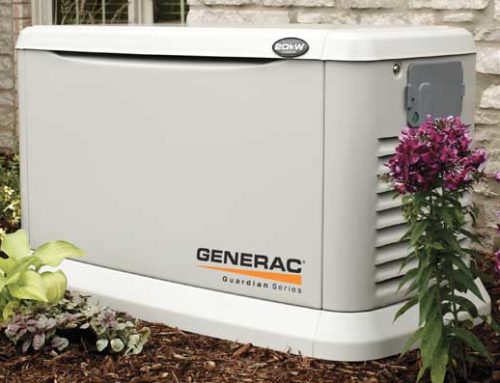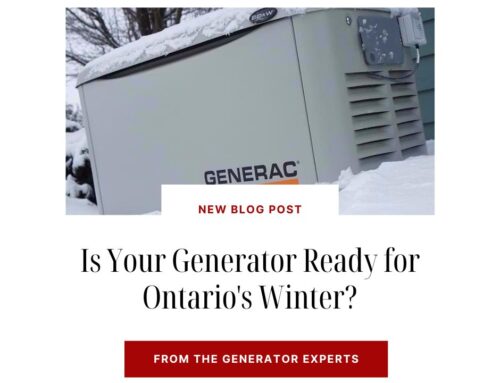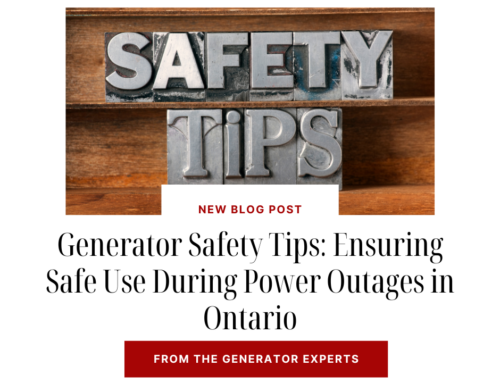As a Generator installer I frequently get asked why one should choose the home standby option, when a portable generator is available for less money? After all, manufacturers produce portable units today that can power up the essentials, and both produce electricity right? Power from a portable is the same as power from a home standby unit isn’t it? The practical answer is no. Power quality varies greatly with the use of a portable, and this can affect the sensitive appliances within your home. While a permanently installed home standby unit is more money than a portable it is not nearly the same solution.
Consider the code compliant (many are not) installation of a manual portable generator / transfer switch solution as a backup source for your home. Usually the manual transfer switch is mounted near the homes breaker panel with cabling to an exterior mounted inlet.
A Common Drawback of Portable Generators and Manual Transfer Switches
Consider this likely scenario – portable generator solution installed.
The power goes out, someone must go get the portable generator from where it has been stored. Make no mistake, even on wheels a portable that’s capable of running most of your home is a heavy piece of equipment. This, according to Murphy will happen when it’s dark out, you have no light other than a flashlight, and it may even be cold and snowing. After all, you did just have a power outage, adverse weather could be likely. Rummaging through the garage or shed in lousy conditions you find the generator and you drag it, possibly through the snow, or carry it to the power inlet location on the exterior of your home. Once there you find the cord that is made to go from your portable unit to the power inlet and you plug it into the generator and the power inlet. Once this is done, the best case scenario is the portable starts right up. What we have found with those who don’t pull out the portable unit and exercise it with some regularity is this is not the case. It’s a hard start or maybe a no start. Have you conditioned the fuel in the generators tank and fuel delivery system for storage? Have you conditioned the fuel in all your stored fuel containers for storage? Will any of that fuel work, or is it now varnish. Just how many fuel storage containers do you have on your residential property?
Are you comfortable with that? Is your home insurance company ok with that!!??
Now you hopefully have not had to tinker with a finicky generator and it’s finally running. You go inside the home and you manually transfer the switch and power up the select loads on your protected panel. All is good now presumably. Portable generators consume 12 to 20 gallons of fuel per day. Their tanks often don’t hold more than three. Every 3-6 hours you will need to refill the tank on the portable. If you haven’t stored a dangerous amount of fuel on your property you are dependent on the local fuel station. In the past during extended outages the local fuel stations have been inoperable too! Now what?!!!
In addition to the above, portable generators tend to be noisier than home standby units. They are not enclosed in any sort of enclosure. If used in inclement weather will you need to build some sort of canopy to keep the elements from affecting its operation?
The biggest “con” of the portable generator as a Home backup solution is that IT DOES NOT WORK IN YOUR ABSENCE!!! This is the largest factor separating the two solutions effectiveness in my opinion.
Backup Power Your Home With
The Home standby generator and Automatic transfer switch are installed permanently. The cabling, and fuel piping that is required is permanently installed as well. Manufacturers like Generac generators have gone a long way to make standby units that produce a good power quality. The home standby will be positioned outside your home, and the transfer switch will be either outside or inside the home. The purpose of all transfer switches, manual or automatic is to ensure that power from the generator and power from the utility never come in contact with each other. The magic of the automatic transfer switch is that the transfer between utility and emergency (generator) power happens with no intervention by anyone.
The Effectiveness of Home Standby Generators and Automatic Transfer Switches
Consider this likely scenario. (Home standby unit installed)
The power goes out, be it day or night. The house goes quiet for three seconds until you hear the comforting familiar sound of your Home standby generator starting up and running outside. Another 10 seconds, and the lights come on assuring you and your family the furnace, hot water tank, sump pump and stove are all operational despite the loss of utility power. You have not lifted a finger since the loss of utility power, and within seconds your selected loads, or your whole home (depending on your chosen installation) are all running as normal. It doesn’t matter how long the outage lasts as your home standby generator is piped directly into your natural gas or propane supply and never requires filling up. No storing dangerous fuel on site, no wondering if it will start, no dragging the unit into place.
After hours, days or a week, the utility power returns, and your transfer switch returns the home to utility power and the generator shuts down and is ready and armed to go again. Absolutely no intervention was required to make this process work seamlessly. And best of all, all this will happen whether you are in your home or not!





